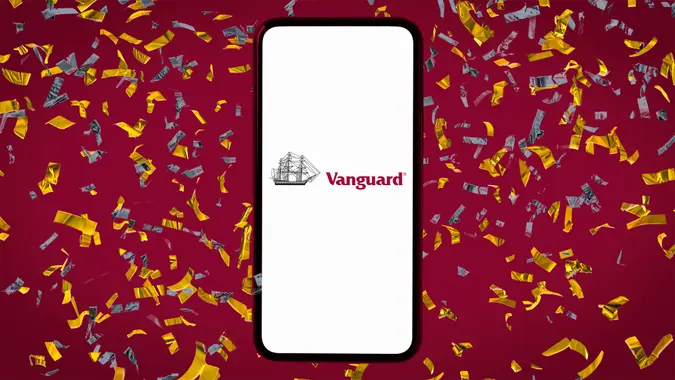8 Best 3-Year CD Rates Today: November 2025 — Earn Up to 3.90% APY

Commitment to Our Readers
GOBankingRates' editorial team is committed to bringing you unbiased reviews and information. We use data-driven methodologies to evaluate financial products and services - our reviews and ratings are not influenced by advertisers. You can read more about our editorial guidelines and our products and services review methodology.

20 Years
Helping You Live Richer

Reviewed
by Experts

Trusted by
Millions of Readers
Three-year CDs are popular because they’re short enough to give you liquidity, but long enough to earn solid interest. Sallie Mae Bank has the best three-year CD rate, paying APY.
Today’s Best 3-Year CD Rates
When you put your money in a deposit account, you want to maximize your earning potential. Here’s a look at the best rates for three-year CDs currently available.
| Bank or Credit Union | APY | Minimum Opening Deposit |
|---|---|---|
| Sallie Mae Bank | $2,500 | |
| Synchrony Bank | $0 | |
| Bread Savings | $1,500 | |
| Randolph-Brooks Federal Credit Union | to | $1,000 |
| Alliant Credit Union | to | $1,000 |
| First Internet Bank of Indiana | $1,000 | |
| Popular Direct | $10,000 | |
| BMO | for the 35-month CD | $1,000 |
Sallie Mae Bank
- APY:
- Account minimum: $2,500
- Early withdrawal penalty: 180 days of interest
As an online bank, Sallie Mae Bank offers a high interest rate for a three-year CD. The CD also has more lenient early withdrawal penalties than other institutions on the list.
Pros
- High interest rate
- More lenient early withdrawal penalty than others on the list
Cons
- High minimum opening deposit
- No physical locations
Synchrony Bank
- APY:
- Account minimum: $0
- Early withdrawal penalty: 180 days of simple interest, though no penalty for withdrawing on interest
Synchrony Bank’s three-year CD requires no minimum balance, so you can put in as much or as little as you want. If you withdraw some or all of your principal early, you’ll pay 180 days’ worth of simple interest as a penalty, but there’s no penalty for withdrawing interest.
Pros
- High interest rate
- More lenient early withdrawal penalty than others on the list
- No minimum opening deposit
Cons
- No physical locations
Bread Savings
- APY:
- Account minimum: $1,500
- Early withdrawal penalty: 180 days of interest
Bread Savings has a three-year CD with a high interest rate, and the early withdrawal penalty is also manageable. Its CD minimum opening deposit requirements are also still not as high as a few of the other options on this list.
Pros
- High interest rate
- More lenient early withdrawal penalty than others on the list
Cons
- No physical locations
- Steep minimum opening deposit, but a few on the list are even higher
Randolph-Brooks Federal Credit Union
- APY: to
- Account minimum: $1,000 to $4,999.99
- Early withdrawal penalty: 180 days of interest
Randolph-Brooks Federal Credit Union pays between and , depending on the amount you deposit. For a minimum of $1,000 to $4,999.99, you’ll earn APY. To earn the most on your money, you will need to deposit $75,000 or more to unlock the APY. You’ll pay 180 days’ interest as an early withdrawal penalty if you take your money out before the three years are up.
You may join Randolph-Brooks Federal Credit Union if you live, work, go to school or worship in Texas. You may also qualify for membership if you volunteer for certain organizations or serve at a military post in certain areas in Texas.
Pros
- Good interest rates overall, and can earn a higher APY with a higher account balance
- More lenient early withdrawal penalty than others on the list
- Membership perks as a credit union
Cons
- Only has branches in Texas
- Other banks on this list have a lower minimum opening deposit
- Need to meet certain membership requirements
Alliant Credit Union
- APY: to
- Account minimum: $1,000
- Early withdrawal penalty: Up to 180 days of interest
Alliant Credit Union’s three-year certificate pays a good interest rate and has standard early withdrawal penalties. You’ll pay up to 180 days’ interest as a penalty for early withdrawal, but no more than the number of days the CD has been open, so you will at least get your initial deposit back if you have to cash in early.
The credit union also has many ways to join. You can open an account with Alliant if you work at a partner organization, live in an eligible community near its Corporate Headquarters in Chicago, or become part of the Alliant Credit Union Foundation.
Pros
- Good interest rate, and can earn a higher APY with a higher account balance
- More lenient early withdrawal penalty than others on the list
- Strong mobile banking
Cons
- Need to qualify for membership, but the criteria are more lenient than standard credit unions
- Other banks on this list have a lower minimum opening deposit
- No physical locations
First Internet Bank of Indiana
- APY:
- Account minimum: $1,000
- Early withdrawal penalty: 360 days of interest
First Internet Bank of Indiana might not pay the highest interest rate on its three-year CD, but it’s still a pretty competitive rate overall.
Pros
- Good interest rate
Cons
- Steep early withdrawal penalty
- Other banks on this list have a lower minimum opening deposit
- No physical locations
Popular Direct
- APY:
- Account minimum: $10,000
- Early withdrawal penalty: 365 days of interest
Popular Direct pays a good APY on its three-year CD, so it might be a good option for savers who can deposit a significant amount upfront.
Pros
- Good interest rate
Cons
- No physical locations
- Steepest minimum opening deposit on this list
- Steep early withdrawal penalty
BMO
- APY:
- Account minimum: $1,000
- Early withdrawal penalty: 270 days of interest
BMO offers CD specials, so you can earn a higher rate than standard CDs. Its 35-month CD special pays a higher rate than its three-year standard CD, but keep in mind that specials can change at any time.
Pros
- Decent interest rate
- Strong branch presence throughout the United States
Cons
- Steep early withdrawal penalties
- Other banks on this list have a lower minimum opening deposit
Good To Know
A CD usually pays a higher interest rate than a traditional savings account or checking account, because when you buy a CD, you agree to leave your money for a fixed period. In exchange, the bank will give you a higher interest rate that won’t change over the term of the CD.
If you take your money out before the term is over, you’ll be penalized. The penalty is typically a fixed amount of the interest you earn on the CD. In most cases, if you open a three-year CD and then take the money out within the first six months, you’ll lose money. The penalty will be greater than the amount of interest you’ve earned, so you’ll get back less than the amount you deposited.
How Much Can You Earn with a 3-Year CD Right Now?
You can earn a good amount of money in a CD, but it all depends on how much you deposit upfront. This chart calculates how much you can earn on a three-year CD earning 3.60% APY with various deposit amounts:
| CD Deposit | Total Interest Earned in 3-Year CD at Maturity | Total Balance of 3-Year CD at Maturity |
|---|---|---|
| $1,000 | $112 | $1,112 |
| $5,000 | $560 | $5,560 |
| $10,000 | $1,119 | $11,119 |
Three-Year CD Rate Movement Tracker
This chart shows how national average rates for three-year CDs have fluctuated in 2025, using data from the FDIC
| Month | National Average Rate of 3-Year CDs |
|---|---|
| January 2025 | 1.32% |
| February 2025 | 1.31% |
| March 2025 | 1.35% |
| April 2025 | 1.35% |
| May 2025 | 1.35% |
| June 2025 | 1.34% |
| July 2025 | 1.34% |
| August 2025 | 1.34% |
| September 2025 | 1.33% |
| October 2025 | 1.33% |
Are 3-Year CD Rates Going Up or Down?
In 2025, three-year CDs have maintained the same rates. But rate cuts by the Federal Reserve could change your finances. The Fed’s decisions impact bank account interest rates. When the Fed cuts rates, banks usually lower CD rates.
According to the latest Summary of Economic Projections released by the Fed, the Fed projects several rate cuts in the future. However, projections can change over time, and there’s disagreement between Federal Reserve board members on how quickly rates should be cut.
In 2022 and 2023, the Fed raised interest rates to tackle inflation. CD rates went up rapidly. The Fed’s goal has been to lower inflation to 2% while also maintaining maximum employment and stable prices.
In 2024 and 2025, the Fed has mostly maintained rates, while only cutting rates a few times. CD rates have declined slightly, but they’re still among the highest seen in the last 20 years when you look at historical CD rates.
You might notice that short-term certificates are higher than long-term certificates, including three-year CD rates. This is because you’re seeing an inverted yield curve. It might be a bad sign for the economy, since there’s economic uncertainty.
Should You Open a 3-Year CD Today?
A three-year CD can be an important component of your savings and investing strategy, but only if that timeframe makes sense for your goals. You might like a three-year CD if you want a low-risk account for storing money. But take into consideration the early withdrawal penalty, and decide if accessibility really matters to you.
You could choose to open a high-yield savings account or money market account instead of a CD. These accounts also pay higher than traditional savings accounts and give you ways to access your money sooner than a CD. You could also choose to open multiple accounts at once.
How GOBankingRates Chose the Best 3-Year CDs: Methodology
Several factors were analyzed to determine the picks for the best three-year CD rates. Here are the key features GOBankingRates used for comparison:
- The minimum deposit amount needed to open a CD
- Annual percentage yield
- Which CD terms have higher interest rates compared to the national average
- How three-year CD rates compare to other banking products offered
Karen Doyle contributed to the reporting for this article.
Rates are subject to change; unless otherwise noted, rates are updated periodically. All other information on accounts is accurate as of Nov. 18, 2025.
GOBankingRates is a personal finance and consumer interest rate website and an online marketing company serving top-tier banks, credit unions and other financial services organizations. Some companies mentioned in this article might be clients of GOBankingRates, which serves more than 100 national, local and online financial institutions. Rankings and roundups are completely objective, and no institution, client or otherwise, paid for inclusion or specific placement. Any opinions, analyses, reviews or recommendations expressed in this article are those of the author alone and have not been reviewed, approved or otherwise endorsed by the companies included in the article. All fees and rates are subject to change at the issuers’ discretion. Some interest rates might be short-term or promotional offers only, and it is possible additional terms and conditions must be met to obtain the interest rates listed. Rates and availability might vary by region. Verify terms and conditions before opening an account.
GOBankingRates bases its assessment of “best” and “top” products on the above-stated parameters to create a baseline for comparison. This assessment is an approximation of “best” and “top” designed to help consumers find products that might be appropriate for them. There could be other options available as well. Consumers should consider various options appropriate for their circumstances.
Editorial Note: This content is not provided by any entity covered in this article. Any opinions, analyses, reviews, ratings or recommendations expressed in this article are those of the author alone and have not been reviewed, approved or otherwise endorsed by any entity named in this article.
Our in-house research team and on-site financial experts work together to create content that’s accurate, impartial, and up to date. We fact-check every single statistic, quote and fact using trusted primary resources to make sure the information we provide is correct. You can learn more about GOBankingRates’ processes and standards in our editorial policy.
- Federal Reserve. "Federal Open Market Committee."
 Written by
Written by  Edited by
Edited by 

























